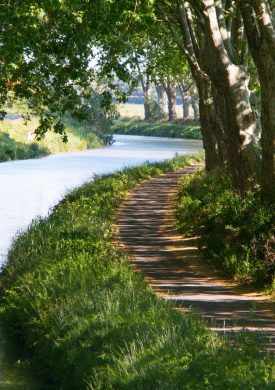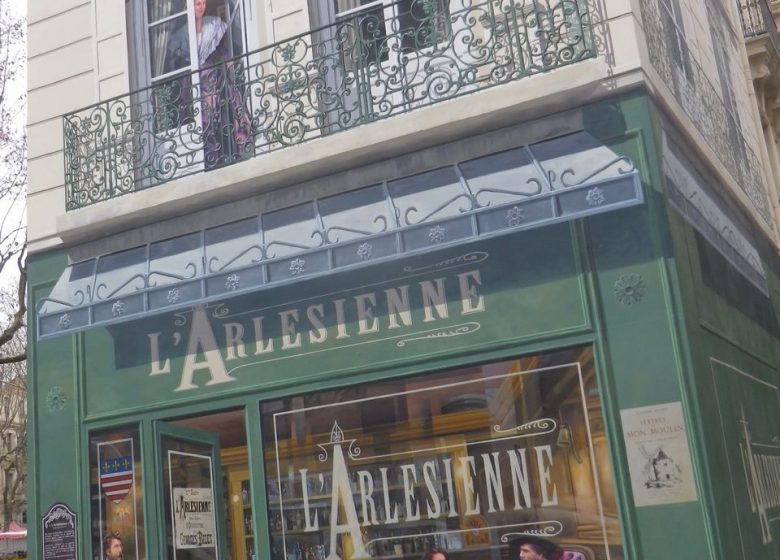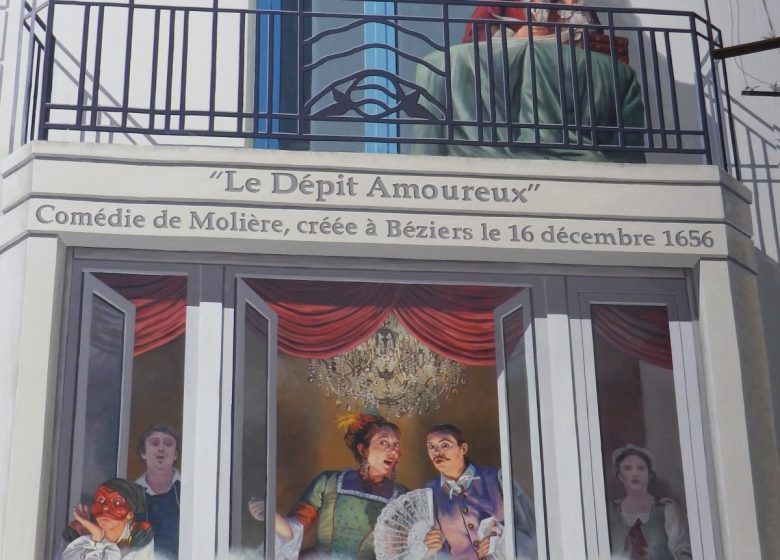Route type: Pedestrian
Distance: 2.9km
Duration (average): 01:00
Level: Very Easy
Elevation: 66D+
Départ : BEZIERS
Boucle
Let's discover the History of Béziers through amazing and lovely fresco ("trompe-l'oeil" in French whose meaning includes the idea of an optical illusion).
View route
BEZIERS
1
Molière et "Le dépit amoureux"
1- Molière Molière and "Le dépit amoureux " (Alphonse Mas Avenue) : the love-tiff was first represented in Béziers just behind the fresco on Place de l'Ancienne Comédie towards the end of 1656 when the States General of Languedoc were assembled in town . It met with great success.
2
L'arrivée du train en gare de Béziers
2- The arrival of the train in Béziers The Béziers train station was inaugurated on January 19 , 1858, and the first train "Bordeaux-Sète" stopped there on April 22. Freight train only: the railway did not open to passenger traffic in Béziers until September 1859. Station, lines, tracks, equipment, employees: everything was financed by the Compagnie des Chemins de Fer du Midi and the Canal Latéral à la Garonne. With such a name, it is not surprising that the company -created in 1852 by the Péreyre brothers- is closely linked to the Canal du Midi and its little brother in the Garonne... In fact, the company runs both canals and manages thousands of plane trees planted on the banks of the Canal. The company thus feeds a double Atlantic-Mediterranean link: by rail and by river. 2 funny details about this fresco : Pay attention to the locomotive driver's head: his face doesn't remind you of somebody famous ? It is top French actor Jean Gabin , in one of his pre-war leading roles, "the Human Beast". He played a compulsive criminal who drove "Lison", a steam locomotive - film, released in 1938 and directed by Jean Renoir, based on a story written by Emile Zola). How can you guess that you are in Béziers train station? On the fresco, you see people living with and in the station (the stationmaster, the driver, passengers in full dress), but not the building. Well now, raise your nose before going through the main door and look at the central medallion: it represents ... a camel's head, "lou camel", totemic animal of Béziers. The Compagnie des Chemins de Fer du Midi disappeared in 1938, absorbed by the very young SNCF, but Béziers remains a special place: it is the center of collection of SNCF memory in Occitania !2
3
Le chemin de Compostelle (Place des casernes)
3- The way to Compostela (Barracks Square) This path, "lo camin roumieu" (the way to Rome) comes from Arles, arrives in Béziers via St Thibéry, then continues throught the plain towards Capestang, Carcassonne whence its name "chemin du piémont". This itinerary is an alternative to the mountain path (Bédarieux/Castres/Toulouse). For a long time in disinheritance, it reappears today. The fresco "Compostela" painted on the Place des Casernes, is very close to the church of St. Jacques and to the pilgrims' stopover (gîte "lo bon camino" -the good path-, opened in 2016). And in order to follow the right direction through Béziers the jacquaires like the one who animates the fresco, identify on the ground the bronze cabochons (taco tiles ) carrying the shell and the name "lo camin roumieu"?
4
La révolte vigneronne de 1907 (angle rue St Jacques)
4- The winemakers revolt in 1907 Marcelin Albert, a wine-grower from Argeliers (Aude), leader of the movement; as well as an infantryman of the 17th Line Infantry Regiment (from Béziers, whose conscripts are sons of wine-growers, wine-growers themselves) are represented there. The origin of the crisis? In 1907, the Languedoc region provided strong harvests, but wine was massively imported from North Africa and any others, artificial, were smuggled in. Prices regularly fell down and winegrowers turned into into poverty. So they rose up . About 800,000 Languedocians demonstrate in Montpellier, Narbonne, Carcassonne, Nîmes. The State used force with repression and sent in the army. But in Béziers, in front of 160,000 demonstrators, the 17th Company put a bayonet in the ground, refusing to fire on his own people . The fresco pays tribute to this refusal . In the summer of 1907, faced with the "contagion" of the movement, the National Assembly passed laws to fight fraud.
5
Jean-Antonin Injalbert (angle rue Viennet)
5- Jean-Antonin Injalbert (corner of rue Viennet) This trompe-l'oeil, integrated into the neighboring facades (have a look on the wrought-iron balconies, rigorously identical, "in real and painted" ...), is dedicated to the sculptor from Béziers, shown here with his friend, also a sculptor, Etienne Dalou. Injalbert, born in Béziers in 1845, is the son of a stonemason. At the age of 16, he's got a job for an ornamentalist, Paul Théodore, who introduced him to drawing. He paid his studies at the Beaux-Arts, with a scholarship "Ville de Béziers" in particular. At the age of 29, he won the Grand Prix de Rome. Back in Paris, commissions flew in: statues for the Paris City Hall, the Bir Hakeim bridge, "La Fontaine du Titan" , ( Plateau des Poètes in Béziers... In 1907, Injalbert rubbed shoulders with Rodin, exhibiting in Munich, Rio de Janeiro, Italy. He divided his time between his Parisian workshop and the Villa Antonine in Béziers, where he invited Camille Saint-Saëns, Laloux, Joffre. Injalbert died in 1933. The Villa Antonine was bequeathed to the city in 1935.
6
Jean Moulin (Place Lavabre)
6- Jean Moulin (Place Lavabre) The most famous biterrois ever ( name of the inhabitants of the town ) was born in Béziers in 1899. After passing the A Level (obtained in high school Henri IV),he studied Law in Montpellier, and then integrated the Prefectoral Body. On the way to a fantastic destiny. The store on the first floor embodies THE passion of Jean Moulin and his "cover" of Resistance fighter: it is his art gallery in Nice, opened in 1942. Lover of painting, excellent draftsman (the works presented in the window are his own ones), he exhibits Bonnard, Chirico, Dufy, Matisse, Utrillo, Suzanne Valadon... His "cover"? His activity as an art dealer, which allows him to circulate, a painting packed under his arm, between Free and Occupied Zones, to accomplish his mission in the Resistance. Jean Moulin is a heroic artist. In December 19, 1964, during the transfer of his ashes to the Pantheon, André Malraux recalled him in his extraordinary speech: "The day when (...) after having him tortured, the Gestapo agent handed him something to write about since he could no longer speak, Jean Moulin drew a caricature of his executioner...".
7
Raimon-Roger Trencavel
7 - The coopers (rue Tiquetone) This fresco and the place where it is painted, illustrate the wine "DNA" of Béziers. The name of the street, Tiquetone (Tiqueta in Occitan), is the onomatopoeia of the sound of hammers, when they resonate on the iron circles that surround the staves of the barrels. But barrels and coopers also embody the metamorphosis of Béziers, under the "July Monarchy" (1830-1848) when the bourgeoisie, through its financial power, acquired the right to vote and took over the reins of the city, refusing the austerity imposed by Louis-Philippe. The coopers were the first to go on strike for the same reason, when the wine prosperity arrived, that Béziers needed space and went out of its old ramparts. During this period, the alleys and the statue of Paul Riquet (1838), the municipal theater (1844), the Pont-Neuf (1846), the canal bridge (1858) were built...
8
Les tonneliers (rue Tiquetone)
8- In the window on the first floor, Raimon-Roger Trencavel (Viscount of Béziers, Ambialet and Agde, of Razès, Albi and Carcassonne) shows his sword: kneaded in the Occitan virtues, including that of the "paratge" (honor, solidarity, loyalty and tolerance), he refuses to hand over the Cathars who reside in Béziers, even though he himself is not a Cathar. Hence the text that appears under his sword. His tolerance made him one of the heroes and one of the first victims of the crusade launched by Pope Innocent III against Cathar heresy. In 1209, the crusaders marched on Béziers, which they literally sacked in July, massacring the population. Raimond-Roger retreated to Carcassonne, which was in turn besieged in August. For lack of water he surrendered, found himself imprisoned in one of his own low pits and the inhabitants of Carcassonne were driven out of the city. A few months later, Raimond-Roger died in the depths of his dungeon, of dysentery or... murdered by his enemy, Simon de Montfort. Raimond-Roger, who died at the age of 24, had married Agnès de Montpellier (the pretty blonde on the 2nd floor) of whom he had a son, Raimond II Trencavel, the last of the line ...
9
Jean-Baptiste Dortous de Mairan
9- Jean-Jacques Dortous de Mairan One of the most brilliant brains born in Béziers. His CV attests to this: - Physicist, mathematician, astronomer, botanist, laureate of the Academy of Sciences of Bordeaux. - Member of the Royal Academy of Sciences from 1718 (and of the learned societies of London, Edinburgh, Uppsala, St Petersburg, Bologna...). - Member of the French Academy from 1743, he was a friend of Voltaire. He scanned the skies, discovered a nebula -called M43-, near the Orion Nebula; he demonstrated that plant life obeys a circadian rhythm. He studied in Toulouse and Paris, before returning to Béziers. In 1723, with Jean Bouillet and Antoine Portalon, he founded the Academy of Béziers (which lasted 70 years, then disappeared), intended to "spread in the South the taste of exact sciences". He died on February 20, 1771 when he was 93 . In 1935, the International Astronomical Union gave the name of Mairan to a lunar crater!
10
St Saëns et son opéra Dejanire (Place St Esprit)
10- St Saëns and his opera Dejanire (Place St Esprit) If the Parisian composer is represented here, in Place St Esprit, it is for 2 reasons: 1- He was very witty ( avoir de l'esprit in French ) 2- on this square, at the back on the left, stands the private mansion of his friend Castelbon de Beauxhostes (creator of the Arena of Béziers); and Castelbon had commissioned Saint Saëns to write an opera to be performed precisely in his arena, famous for ITS extraordinary acoustics. The opera is "Déjanire", whose poster can be read on the wall. Saint-Saëns stayed with his friend Castelbon in this hotel, as indicated by the identification plate near the carriage entrance.
11
Casimir Péret (rue Riciotti)
11- Casimir Péret (Riciotti street) Casimir Péret was born in Béziers in 1801, even before Napoleon became Emperor (1804). But when Casimir Péret died, in 1855, Napoleon III, having successfully carried out his coup d'état, was proclaimed Emperor. An real infamy for the fierce Republican people from Béziers: the Second Republic was proclaimed in February 1848. Casimir was elected Mayor of Béziers. But Louis-Napoléon Bonaparte became President of the Republic. In order to secure a greater and longer power, he fomented a coup d'etat in December 1851. But in Béziers Casimir Péret handled a strong revolt. He lost the battle, was arrested and judged. Some were shot, and he was sentenced to jail. And he died in Cayenne in 1855 while trying to escape. Cayenne is evoked in this trompe l'oeil : see the convict's uniform hanging from a nail, the railings on the windows, the portcullis in front of the entrance, the modest vegetable garden grown by the convicts . Just above, Casimir Péret appears out of the window with the sash of elected Mayor.
12
Arlequin (façade arrière du théâtre municipal)
12-Harlequin (at the back of the theatre) The theatre of Béziers, inaugurated in 1844, is called "à l'italienne", its decor "en bonbonnière". Carefully preserved, restored, it is always there -and it is the only one in France-, welcoming its public during the season of the performances. We can notice the original decorative features, the facade with its high reliefs of David of Angers and its Greek colonnades has just been renovated. It is , as a result, a classification as a Historical Monument since 1975. And then, as a nod to the history of the t art of theatre , a fresco has been created on its back façade as a tribute to the Commedia dell'Arte: "mother" of all the troupes and of modern theater. By the way, say hello to Harlequin...
13
Jean-Marie Cordier (pointe avenue Clémenceau/avenue Ml Foch)
13-Jean-Marie Cordier ( avenue Clémenceau/avenue Foch) Béziers is located on a hill. In the summer, the wells are dry. The women struggle to go down to the River Orb, through the street and the Tourventouse gate, then go up the whole hill with their full jars... Daily fight. Until 1827 ! Because the city issued a tender won by the engineer -and initially locksmith- Jean-Marie Cordier (1785-1859). And in September 23, 1827, he succeeded: Jean-Marie Cordier built a steam engine, installed in a medieval watermill built on the Orb, which pumps and raises some 800,000 liters of water/day to a large cistern in front of Saint-Nazaire Cathedral. The city's fountains fill up with fresh water, supplying the 16,000 or so inhabitants of Béziers! Jean-Marie Cordier becomes the hero of the city. His statue sits enthroned above his mausoleum in the city's old cemetery.
14
L'Arlésienne
14- l'Arlésienne By the way , Alphonse Daudet and Georges Bizet's Arlesienne was not from Arles. She was from Béziers. Her name was Marie Cauffopé, and she lived right there, at the corner of the Allées Paul Riquet and rue Boïeldieu. Please admire them , her on the balcony, and below, sitting in the café, Frédéric Mistral and his nephew, François. François was the fiancé of the beautiful girl but... she was unfaithful. He could not bear this betrayal and committed suicide in 1862. His uncle Mistral told the story to Alphonse Daudet, who transposed it in "les lettres de mon moulin". Georges Bizet (also sitting in the café ) created "l'Arlésienne". What a story !
15
Trompe l'oeil des 9 écluses de Fonseranes
15- 9 locks of Fonseranes You can continue the walk, if you like to "yomp" in town : at the bottom of the avenue de la Marne, you will see the trompe l'oeil dedicated to the 9 locks of Fonseranes, on the Canal du midi. By the way, you are "right on the way" to get there and visit them ...
16
Fresque ASB-H
16 - ASBH Totally opposite, rue Noël Sylvestre (next to the Duguesclin University), it is a fresco to the glory of the ASB-H, the rugby club of Béziers founded in 1911 and 11 times champions of France - now iplaying in the second division.






















